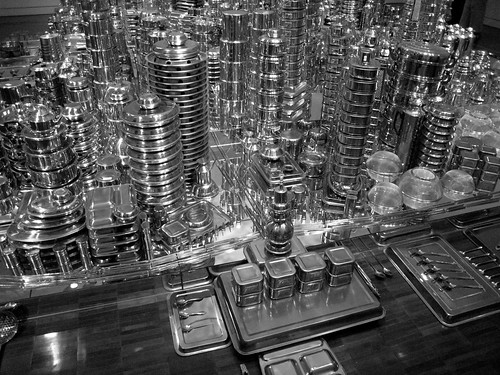… downtown San Francisco modeled in stainless steel pots and pans. If you read the Ethicurean you probably figured that out. The metal model is an installation by artist Zhan Wang at the San Francisco Asian Art Museum. The piece includes clever details such as forks and spoons for piers, and graters, barbecue forks, and tongs for the Golden Gate Bridge.
This installation was of particular interest to me, as I’m currently reading “The Fortune Cookie Chronicles: Adventures in the World of Chinese Food” by Jennifer 8. Lee. The book begins as a fascinating look at the origins of the fortune cookie—a ubiquitous fixture in American Chinese restaurants almost entirely unknown in China. The story, however, takes myriad twists and turns, weaving a multi-threaded narrative of Chinese-American history.
Lee covers various aspects of the Chinese-American experience, including the Chinese Exclusion act of 1882 and the huge underground industry of human trafficking that is the foundation of many Chinese restaurants in America. I’m not sure whether I slept through this particular topic in American history class, or if it figured as a terse sentence or two in my high school American history book (much like the Holocaust—one of the most hideous chapters in recent history was condensed into a paragraph and a photo). The Chinese Exclusion Act was unique in that it banned an entire race from immigrating to the United States and becoming U.S. citizens. Moreover, it denied citizenship to Chinese people already living in the United States at the time. The act remained in effect with amendments until 1943 when it was finally repealed. The 61 years of the Exclusion Act were brutal for Chinese people in America. Chinese Americans were unable to integrate into American society, and often forced to live in ghettos. San Francisco’s Chinatown—today considered a quaint destination by tourists and residents alike—was once a tiny little neighborhood in which Chinese Americans were forced to live.
The passing of the Exclusion Act was motivated by workers and laborers who resented the Chinese immigrants lured by the Gold Rush and work on the Transcontinental Railroad. Convinced that the Chinese were taking their jobs, some workers even went so far as to perpetrate pogroms upon Chinese people.
In 1885, an anti-Chinese rally in Seattle set a deadline for all Chinese to be out of Washington Territory by November 1. Two days after the deadline, residents conducted a giant raid against Tacoma’s Chinatown, where the merchants, who were less transient than the laborers, had remained. Doors were kicked down, bodies were dragged, people were herded like wayward cattle.
The same year, miners in Rock Springs, Wyoming, conspired to drive their Chinese competition out, attacking their settlement with guns and fire. As Chinese miners tried to escape the burning wooden shacks, their attackers forced them back into the flames. Some who fled into the mountains were later eaten by wolves. At least twenty-eight people died.
But the most lurid tale was the Snake River Massacre of 1887. The water in Hell’s Canyon in Oregon ran red with blood as more than thirty Chinese gold miners were killed and mutilated by a group of white men who had conspired to steal their gold and force the Chinese out. Three killers were brought to trial. Not one was convicted…
That Chinese Americans survived such brutal oppression is remarkable. Despite the Exclusion Act, “in the half century from 1870 and 1920, the number of Chinese restaurant workers surged from 164 to 11,438, even though the total number of Chinese employed declined.”
Why was there suddenly an entrepreneurial explosion of restaurants, and why, of all small businesses, did laundries survive?
Cleaning and cooking were both women’s work. They were not threatening to white laborers.
Viewing Wang’s installation with Lee’s book in mind makes his cookware cityscape all the more powerful. The woks, tongs, trays, pots, chopsticks all seem to represent a city supported by so many Chinese Americans who are otherwise invisible. The people who built the railroads, ran the laundries, lived in cramped conditions; the people who cook kung pao chicken and walnut prawns, serve hungry diners, sweep floors, send money home to husbands, wives, children, parents—they’re all here. Like each piece of kitchenware in the exhibit, they too are an integral part of this city.
Quotes from Jennifer 8. Lee’s book “The Fortune Cookie Chronicles: Adventures in the World of Chinese Food.”

